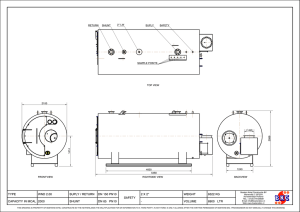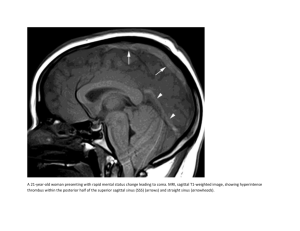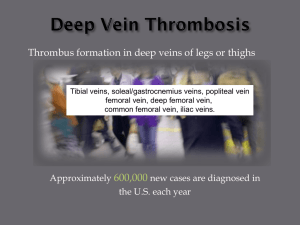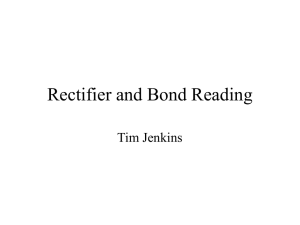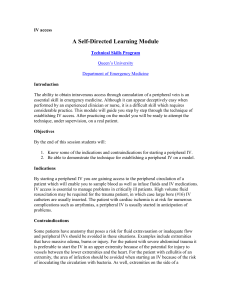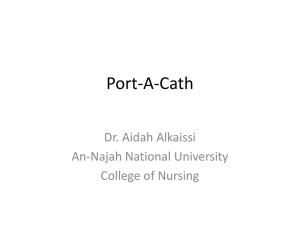here - NeuroLaunch
advertisement
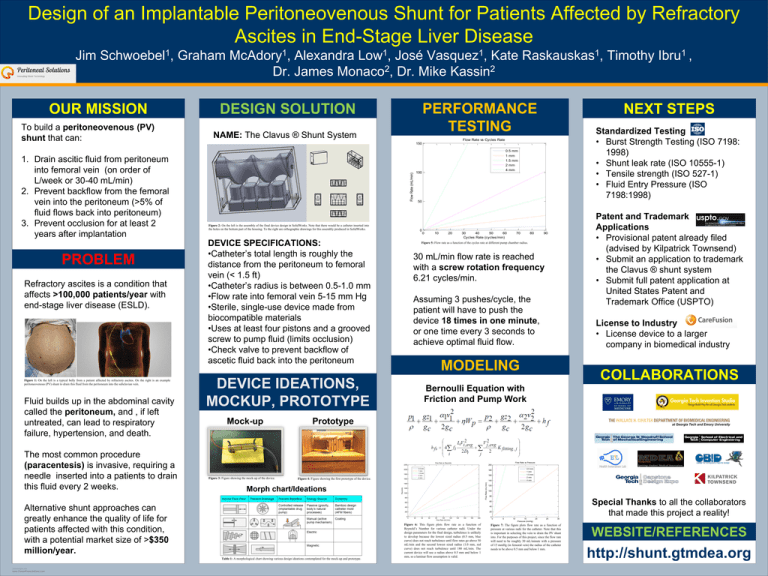
Design of an Implantable Peritoneovenous Shunt for Patients Affected by Refractory Ascites in End-Stage Liver Disease 1. Drain ascitic fluid from peritoneum into femoral vein (on order of L/week or 30-40 mL/min) 2. Prevent backflow from the femoral vein into the peritoneum (>5% of fluid flows back into peritoneum) 3. Prevent occlusion for at least 2 years after implantation PROBLEM Refractory ascites is a condition that affects >100,000 patients/year with end-stage liver disease (ESLD). Figure 1: On the left is a typical belly from a patient affected by refractory ascites. On the right is an example peritoneovenous (PV) shunt to drain this fluid from the peritoneum into the subclavian vein. Fluid builds up in the abdominal cavity called the peritoneum, and , if left untreated, can lead to respiratory failure, hypertension, and death. The most common procedure (paracentesis) is invasive, requiring a needle inserted into a patients to drain this fluid every 2 weeks. 1 Vasquez , Alexandra José Kate 2 2 Dr. James Monaco , Dr. Mike Kassin NAME: The Clavus ® Shunt System 50 Figure 2: On the left is the assembly of the final device design in SolidWorks. Note that there would be a catheter inserted into the holes on the bottom part of the housing. To the right are orthographic drawings for this assembly produced in SolidWorks. 0 DEVICE SPECIFICATIONS: •Catheter’s total length is roughly the distance from the peritoneum to femoral vein (< 1.5 ft) •Catheter’s radius is between 0.5-1.0 mm •Flow rate into femoral vein 5-15 mm Hg •Sterile, single-use device made from biocompatible materials •Uses at least four pistons and a grooved screw to pump fluid (limits occlusion) •Check valve to prevent backflow of ascetic fluid back into the peritoneum 0.5 mm 1 mm 1.5 mm 2 mm 4 mm 0 20 30 40 50 60 Cycles Rate (cycles/min) 80 90 30 mL/min flow rate is reached with a screw rotation frequency 6.21 cycles/min. Assuming 3 pushes/cycle, the patient will have to push the device 18 times in one minute, or one time every 3 seconds to achieve optimal fluid flow. License to Industry • License device to a larger company in biomedical industry MODELING COLLABORATIONS Bernoulli Equation with Friction and Pump Work Prototype Flow Rate vs Pressure Flow Rate vs Reynolds 200 2200 0.5 mm 1 mm 1.5 mm 2 mm 4 mm 2000 1800 Figure 3: Figure showing the mock-up of the device. 70 Patent and Trademark Applications • Provisional patent already filed (advised by Kilpatrick Townsend) • Submit an application to trademark the Clavus ® shunt system • Submit full patent application at United States Patent and Trademark Office (USPTO) Figure 5: Flow rate as a function of the cycles rate at different pump chamber radius. DEVICE IDEATIONS, MOCKUP, PROTOTYPE Mock-up 10 Figure 4: Figure showing the first prototype of the device. 1600 160 140 1400 Alternative shunt approaches can greatly enhance the quality of life for patients affected with this condition, with a potential market size of >$350 million/year. 1200 1000 Table 1: A morphological chart showing various design ideations contemplated for the mock-up and prototype. 120 100 80 Special Thanks to all the collaborators that made this project a reality! 60 400 40 200 20 0 0.5 mm 1 mm 1.5 mm 2 mm 4 mm 180 600 www.PosterPresentations.com Standardized Testing • Burst Strength Testing (ISO 7198: 1998) • Shunt leak rate (ISO 10555-1) • Tensile strength (ISO 527-1) • Fluid Entry Pressure (ISO 7198:1998) 150 100 Timothy 1 Ibru , NEXT STEPS Flow Rate vs Cycles Rate 800 TEMPLATE DESIGN © 2008 1 Raskauskas , PERFORMANCE TESTING DESIGN SOLUTION Flow Rate (mL/min) To build a peritoneovenous (PV) shunt that can: 1 Low , Flow Rate (mL/min) OUR MISSION Graham 1 McAdory , Reynolds Jim 1 Schwoebel , 0 20 40 60 80 100 120 Flow Rate (mL/min) 140 160 180 200 Figure 6: This figure plots flow rate as a function of Reynold’s Number for various catheter radii. Under the design parameters for the final design, turbulence is unlikely to develop because the lowest sized radius (0.5 mm, blue curve) does not reach turbulence until flow rates go above 50 mL/min and the second lowest sized radius (1.0 mm, red curve) does not reach turbulence until 180 mL/min. The current device will use a radius above 0.5 mm and below 1 mm, so a laminar flow assumption is valid. 0 0 5 10 15 Pressure (mmHg) 20 25 30 Figure 7: The figure plots flow rate as a function of pressure at various radii for the catheter. Note that this is important in selecting the vein to drain the PV shunt into. For the purposes of this project, since the flow rate will need to be roughly 30 mL/minute with a pressure of 15 mmHg (in femoral vein) the radius of the catheter needs to be above 0.5 mm and below 1 mm. WEBSITE/REFERENCES http://shunt.gtmdea.org

